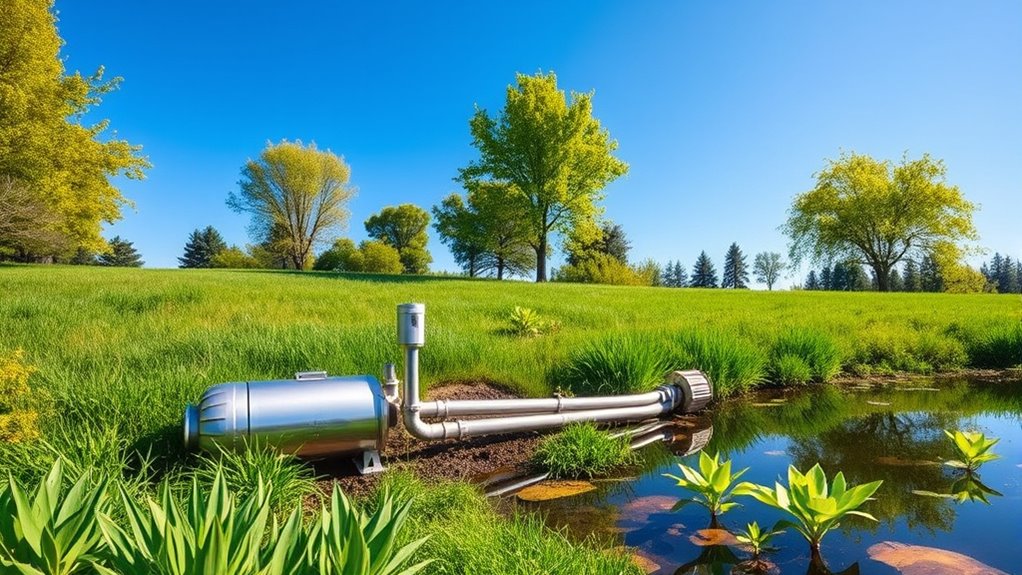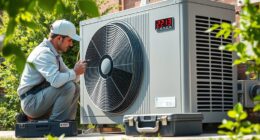Geothermal heat pumps are a clean, energy-efficient way to heat and cool buildings, with minimal environmental impact. They recycle underground heat using closed-loop systems, produce virtually no greenhouse gases, and use little water. Installing them causes little disturbance to land or air quality. While there are some hidden impacts like resource extraction and infrastructure needs, overall, they markedly reduce emissions. To discover more about their environmental effects, keep exploring this sustainable technology.
Key Takeaways
- Geothermal heat pumps have low lifecycle greenhouse gas emissions due to high efficiency and minimal operational pollutants.
- They use mostly closed-loop systems, recycling fluids and requiring minimal water, thus protecting groundwater quality.
- Installation and manufacturing produce some environmental impacts, including resource extraction and land disturbance.
- Their underground infrastructure causes minimal land disruption and has low emissions compared to traditional heating systems.
- Proper management and environmental assessments are essential to mitigate potential seismic, land subsidence, and ecological impacts.
How Geothermal Heat Pumps Operate and Their Efficiency
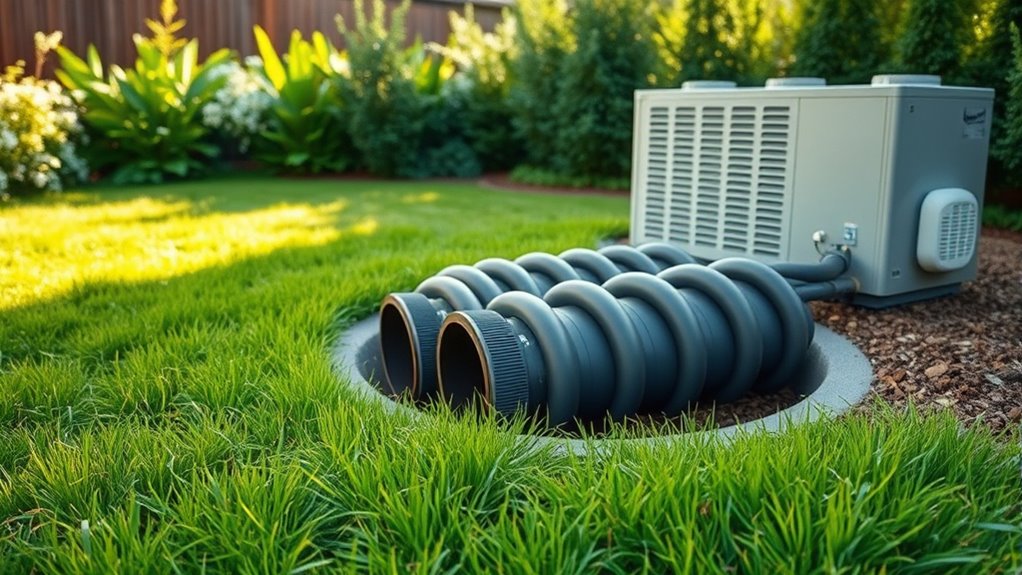
Geothermal heat pumps work by using underground loops filled with a liquid that absorbs the Earth’s stable temperature, providing an efficient source of heating and cooling. These systems leverage renewable ground sources, making them highly energy-efficient. With a Coefficient of Performance (COP) between 3 and 4.5, they produce three to four and a half units of heat per unit of electricity used. Compared to traditional heating systems, geothermal heat pumps can be about 75% more efficient than oil furnaces and nearly half as efficient as gas furnaces. Their high efficiency reduces power consumption and minimizes greenhouse gas emissions. By tapping into natural resources, geothermal heat pumps lessen the environmental impact of heating and cooling systems, making them a sustainable choice for environmentally conscious building management.
Water Use and Environmental Management in Geothermal Systems

Water use and environmental management are key considerations when implementing geothermal heat pump systems. Most systems use a closed-loop design, recycling geothermal fluids within pipes to minimize water withdrawal and prevent water contamination. They typically require only 1 to 4 gallons of water per ton annually, much less than traditional methods, supporting groundwater protection. Proper environmental management involves leak monitoring and maintaining well integrity to avoid environmental impact and ensure system efficiency. These systems generally do not emit pollutants, further reducing risks to water quality. When installed correctly, geothermal heat pumps operate with minimal water use and effectively safeguard groundwater resources. This sustainable approach guarantees that environmental management remains a priority, maintaining the benefits of geothermal energy while protecting water resources.
Air Emissions and Land Impact of Geothermal Heat Pump Installations
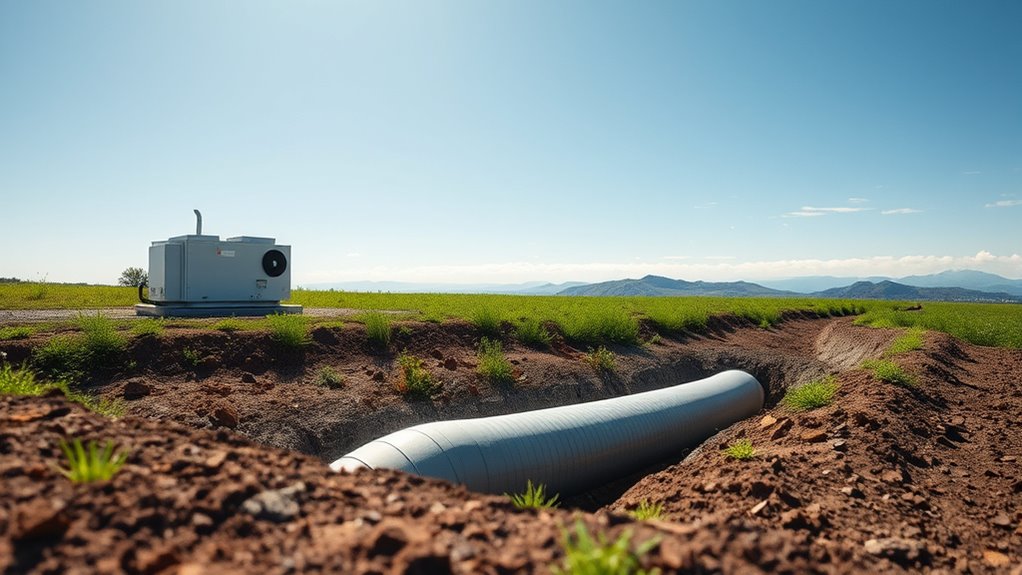
Although the installation process involves underground piping, the overall air emissions from geothermal heat pumps are extremely low. These systems produce minimal air emissions, mostly limited to small amounts of refrigerant gases and negligible particulate matter during operation. Unlike open-loop systems, closed-loop geothermal heat pumps emit virtually no greenhouse gases, greatly reducing their impact on air quality and ecosystems. Construction activities for underground piping can generate temporary dust and emissions, but these are short-lived and localized. The land impact is minimal since most infrastructure is concealed underground, leading to little disturbance to the surrounding environment. Additionally, the high energy efficiency of geothermal heat pumps contributes to reduced overall emissions and environmental footprint. The environmental benefits of geothermal heat pumps are further enhanced by their ability to operate quietly and with minimal noise pollution. Moreover, advances in refrigerant technology help further decrease potential emissions and environmental impact. The development and adoption of environmentally friendly refrigerants can reduce the potential for leaks and further lessen the emission risks. Overall, geothermal heat pumps markedly lower construction emissions and have a negligible effect on land and air quality, making them a sustainable alternative to fossil fuel-based systems.
Lifecycle Emissions and Long-term Environmental Benefits
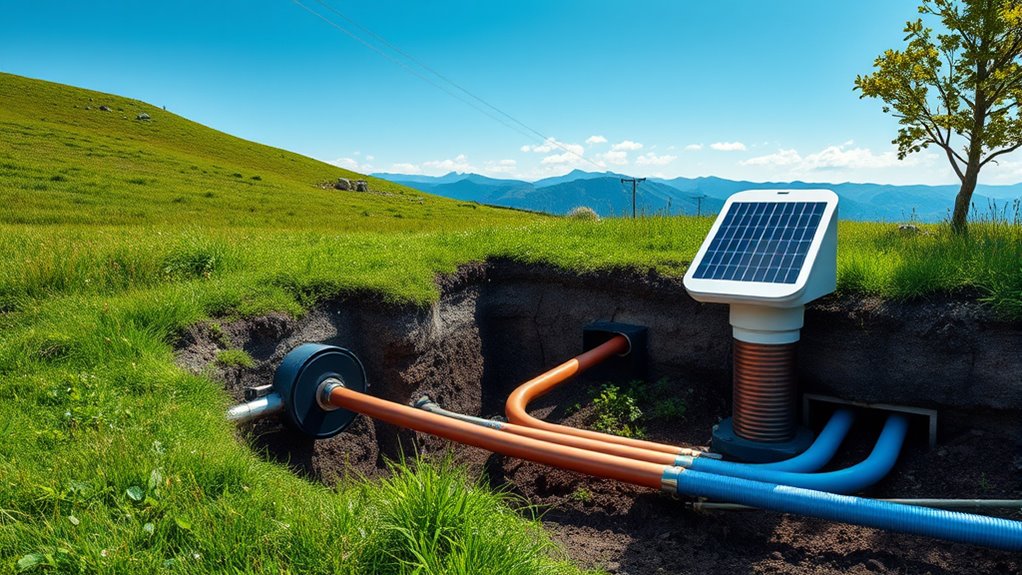
While the manufacturing, installation, and maintenance of geothermal heat pumps do generate some emissions, their overall lifecycle greenhouse gas output remains remarkably low. Their minimal lifecycle emissions primarily come from infrastructure production, with negligible operational greenhouse gases. Compared to fossil fuel systems, geothermal heat pumps greatly reduce long-term carbon footprints, supporting climate change mitigation. Lifecycle analysis shows that widespread adoption can cut building-related emissions by up to 75%, making them a low-emission technology for sustainable building practices and decarbonization efforts. Life cycle analysis confirms their environmental advantages over traditional heating systems. Additionally, ongoing innovations in renewable energy integration are further enhancing their sustainability credentials, demonstrating their vital role in climate-friendly technology development. Incorporating biodiversity-friendly practices in the installation process can further minimize their environmental impact.
Addressing Hidden and Unpriced Environmental Costs
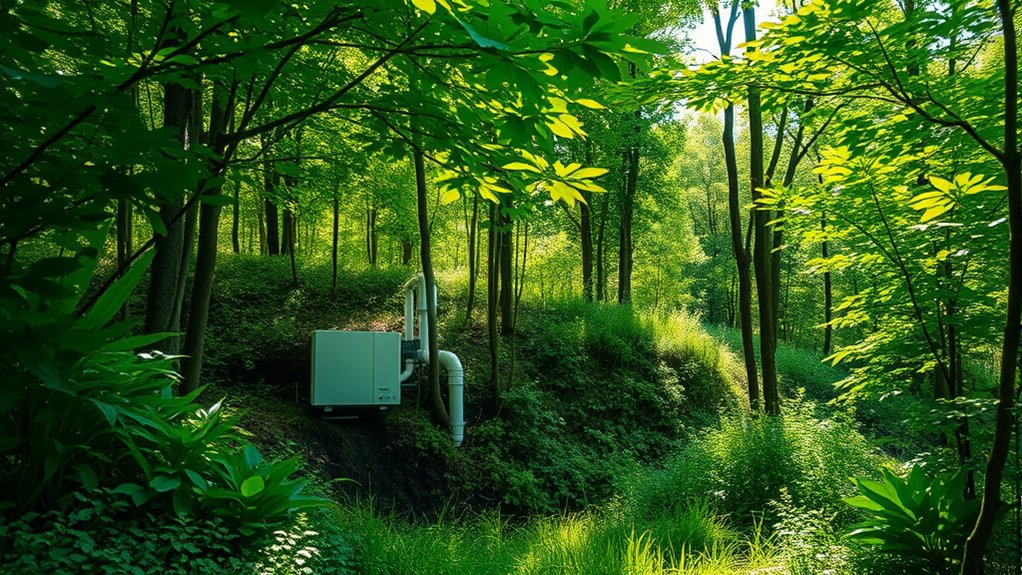
Have you considered that the true environmental costs of geothermal heat pumps extend beyond their direct emissions? These hidden costs stem from resource extraction and infrastructure development, which can cause ecological disturbances and land use changes. Addressing these impacts involves:
Consider the hidden environmental impacts of geothermal heat pumps, including resource extraction and land use changes.
- Conducting thorough environmental assessments to evaluate ecosystem effects, habitat disruption, and soil disturbance. Incorporating comprehensive impact analysis helps identify potential risks early in project planning.
- Recognizing lifecycle impacts from manufacturing, installation, and maintenance, which contribute to overall environmental degradation.
- Monitoring potential seismic activity and land subsidence resulting from extensive ground loop installation and land use changes.
- Considering the market growth of geothermal technologies, which underscores the importance of understanding and mitigating their environmental footprint. Additionally, implementing sustainable resource management practices can help minimize long-term ecological impacts as adoption increases.
- Incorporating environmental impact mitigation strategies throughout the entire lifecycle of geothermal heat pump systems to further reduce ecological disturbances. Moreover, advancing technological innovations can help reduce resource consumption and environmental harm associated with system production and operation.
Frequently Asked Questions
How Does Geothermal Heat Pump Affect the Environment?
You might wonder how geothermal heat pumps impact the environment. They substantially cut greenhouse gases by using Earth’s stable underground temperatures instead of burning fossil fuels, reducing your building’s CO₂ emissions by up to 75%. Their high efficiency minimizes electricity use, and they don’t release pollutants like sulfur dioxide or heavy metals. Plus, their installation causes minimal land disturbance, making them a sustainable choice that supports cleaner air and a healthier planet.
How Does Geothermal Impact the Environment?
Think of geothermal energy like a gentle giant that quietly helps the environment. When you use geothermal systems, you drastically cut greenhouse gases—up to 75%—and use minimal land, keeping ecosystems intact. They emit very little gases, mainly small amounts of hydrogen sulfide and CO₂. Overall, your choice reduces pollution, consumes less energy, and leaves a tiny environmental footprint, making it an eco-friendly option for sustainable heating and cooling.
What Is the One Bad Thing About Using Geothermal Heat Pumps?
The main downside of using geothermal heat pumps is the risk of land subsidence if wastewater reinjection isn’t managed properly. You might also face localized land disturbances and noise during installation, which can affect nearby communities and wildlife. While these issues are generally small and manageable with proper planning, neglecting these factors could lead to environmental concerns and impact the long-term stability of the site.
What Are Some Environmental Risks Associated With Using Heat Pumps?
Imagine a gentle ripple in a serene pond—you’re concerned about potential disturbances. When using heat pumps, you might worry about land disruption during installation or leaks from refrigerants. If not properly maintained, underground pipes could cause soil or water issues. But overall, these risks are minimal compared to fossil fuels, especially when you guarantee proper installation and regular upkeep, keeping your environment safe and healthy.
Conclusion
As you explore geothermal heat pumps, imagine a quiet underground river quietly warming your home, leaving a gentle footprint on the Earth. With careful management, you help keep this underground resource pristine, like a hidden treasure. Embracing their long-term benefits is like planting a tree that grows stronger with each passing year. By understanding the true environmental impact, you become a steward of a cleaner, greener future—where innovation and nature flow seamlessly together.
